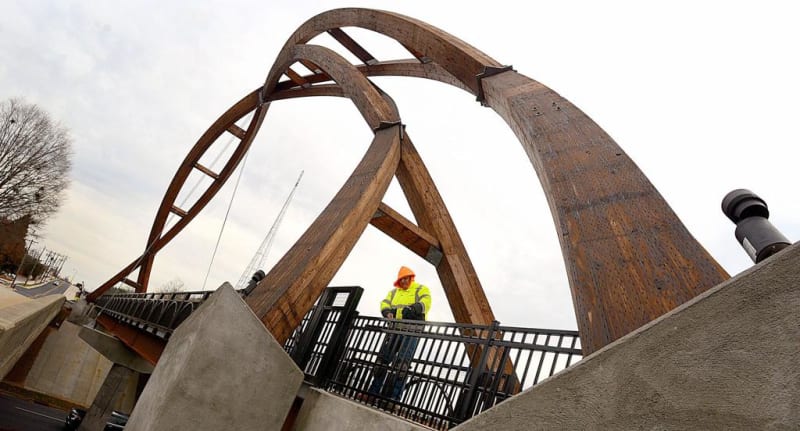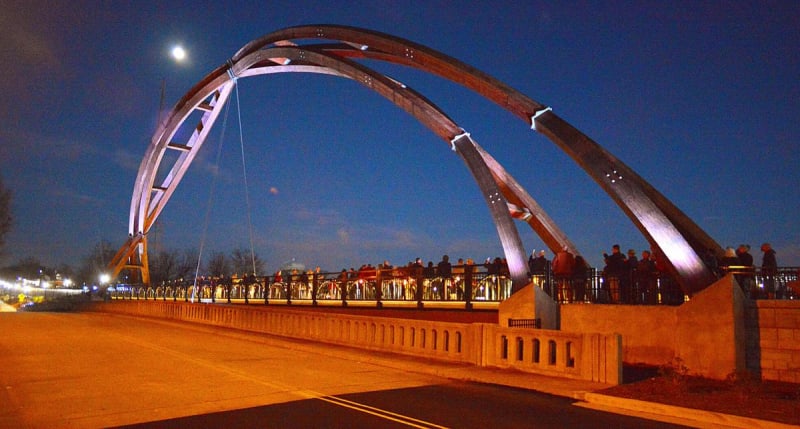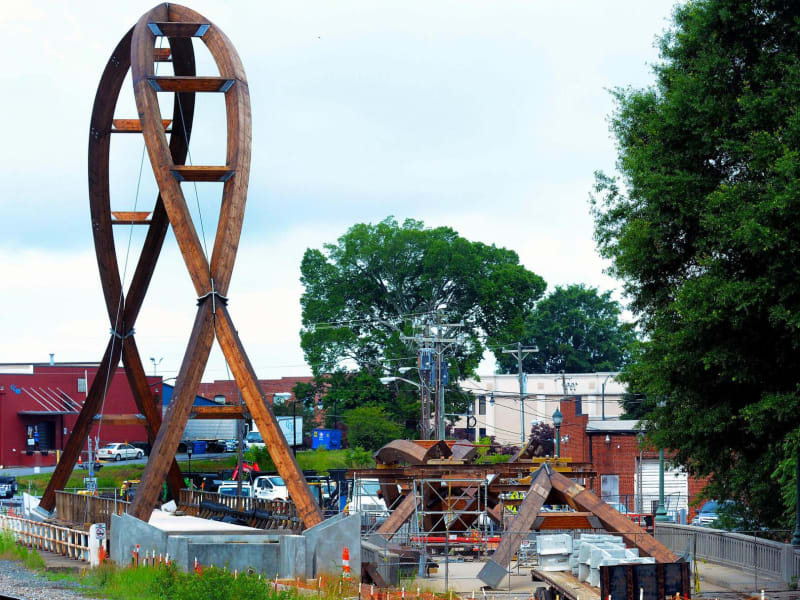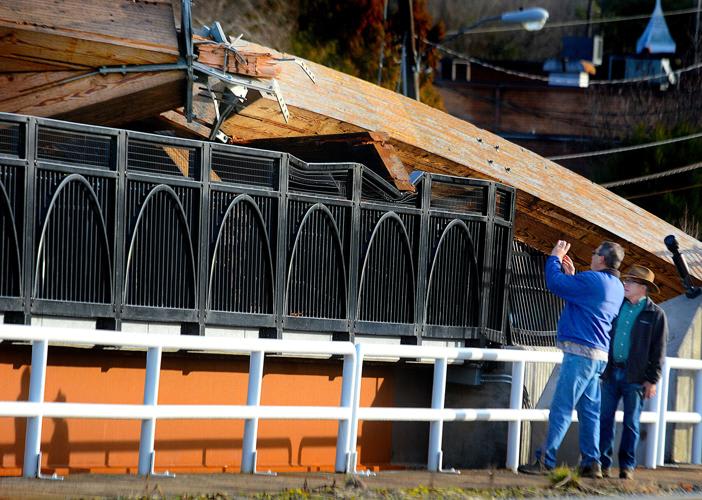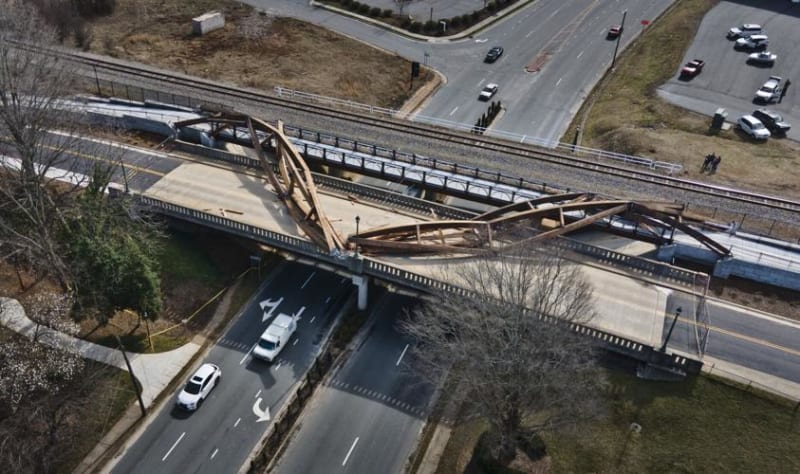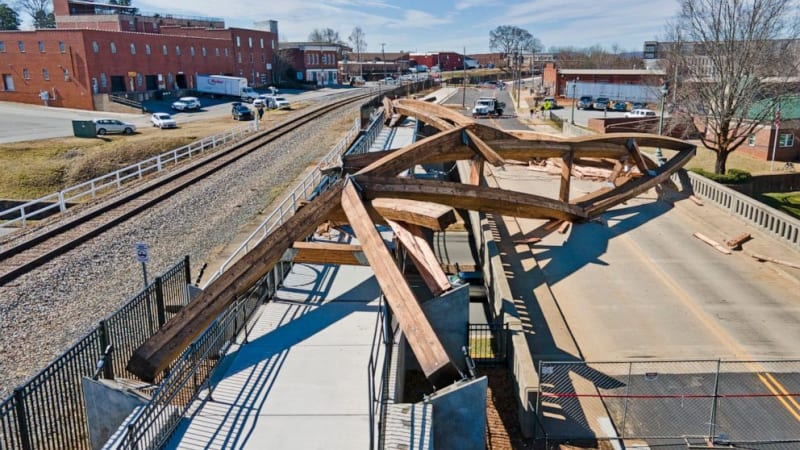Navigation
Install the app
How to install the app on iOS
Follow along with the video below to see how to install our site as a web app on your home screen.
Note: This feature may not be available in some browsers.
More options
Style variation
-
Congratulations MintJulep on being selected by the Eng-Tips community for having the most helpful posts in the forums last week. Way to Go!
You are using an out of date browser. It may not display this or other websites correctly.
You should upgrade or use an alternative browser.
You should upgrade or use an alternative browser.
40-ton timber arches collapse in Hickory, NC 35
- Thread starter bugbus
- Start date
- Status
- Not open for further replies.
dik (Structural) 23 Feb 22 01:38 said:... nearly matches the blue cable trajectory.
Yes, that is what I was trying to say earlier, however from a pure technical standpoint, no matter how less effective the guy wire is, something still has to bend or break before the motion can proceed. But the idea that the guy wire might become irrelevant is of concern. As I've since looked at the videos closer, I do see the structure start to lean over at the top before anything else starts to fail, at least anything that can be reconciled in the videos.
That's correct, but the cable if it's in compression will not restrain the structure to prevent it from breaking somewhere else. Depending where the elevated hinge is, the cables may be totally useless and people may have been relying on them for lateral support.
Cable in compression will allow that to happen. I got the idea from your clips, because it appeared they started to rotate with little restraint.![[pipe] [pipe] [pipe]](/data/assets/smilies/pipe.gif)
Rather than think climate change and the corona virus as science, think of it as the wrath of God. Feel any better?
-Dik
Cable in compression will allow that to happen. I got the idea from your clips, because it appeared they started to rotate with little restraint.
![[pipe] [pipe] [pipe]](/data/assets/smilies/pipe.gif)
Rather than think climate change and the corona virus as science, think of it as the wrath of God. Feel any better?
-Dik
Agreed, Tom, but the cables may be nearly ineffective, and would be less effective if there was any horizontal movement of the base to the left.
Rather than think climate change and the corona virus as science, think of it as the wrath of God. Feel any better?
-Dik
Rather than think climate change and the corona virus as science, think of it as the wrath of God. Feel any better?
-Dik
Dik, please review my first and second posts in this thread (Sym P. le (Mechanical) 21 Feb 22 00:06, and 21 Feb 22 02:07). I've been saying this since this thread started. I've just been trying to suss out the reasonableness of such an assertion in light of the many other factors that could be at play. The mount blocks for the clevis connections at the top of the arch, for instance, are either bolted in place or field welded. They appear not to have suffered any damage as they detached from the structure (see previously posted images). That is odd.
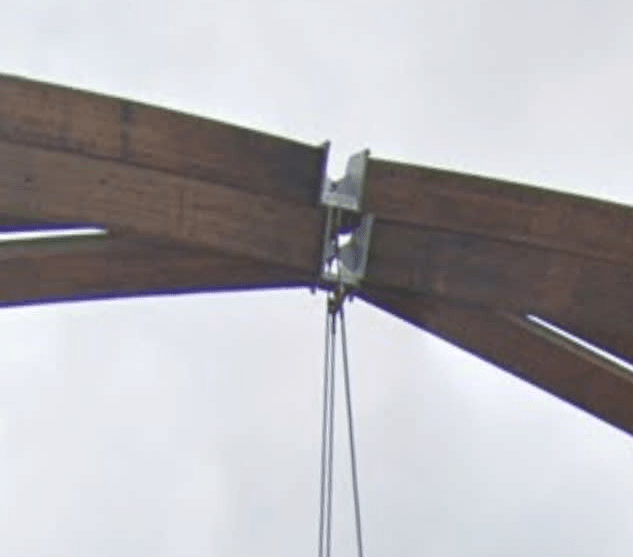

Electronbelt
Industrial
Interestingly enough, this artist render from 2017-2018 had a lot more stays...
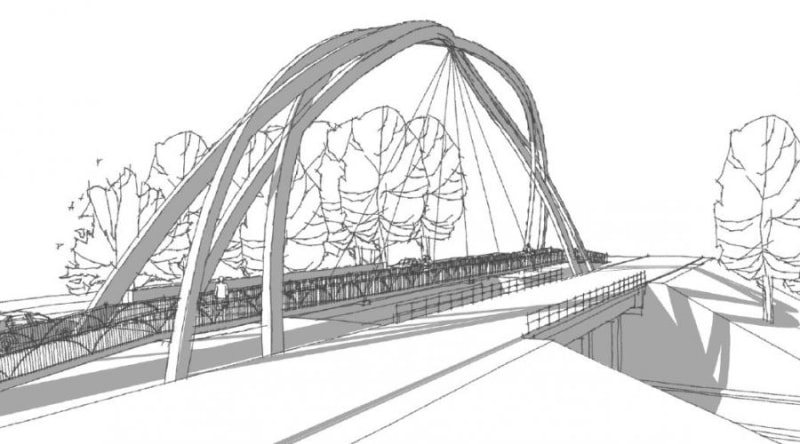

Oh sh*t... I should have realised that.
If you look at the sketches, the white curve shows the approx cable location if the arches were pinned at the base... the red curve shows the cable location with the arch rotating about an elevated point... the effect is that the bracing is severely compromised. Earlier in my comments, I noted:
...and the first rule of engineering is that you can't push on a rope.
Rather than think climate change and the corona virus as science, think of it as the wrath of God. Feel any better?
-Dik
As I think about this more, if the wishbone connection swivels, the structure is indeterminate. The wishbone pivots on its base, the guy wire pivots off the crosshead, and the upper arch just takes up the space in between (the top of the wishbone and the top of the guy wire). It's a miracle this thing didn't fall over sooner. Q.E.D.
To simplify the analysis, did they possibly introduce a pin at the upper intersection so they could be handled with simple statics? ![[pipe] [pipe] [pipe]](/data/assets/smilies/pipe.gif)
Rather than think climate change and the corona virus as science, think of it as the wrath of God. Feel any better?
-Dik
![[pipe] [pipe] [pipe]](/data/assets/smilies/pipe.gif)
Rather than think climate change and the corona virus as science, think of it as the wrath of God. Feel any better?
-Dik
Yup, but because of symmetry you should have a fairly close static analysis. They may have chosen pins to do this. Moment connections with wood are a real b*tch... so maybe to eliminate these, too. Just WAGs until there is more information.
Rather than think climate change and the corona virus as science, think of it as the wrath of God. Feel any better?
-Dik
With lateral load, I believe one cable is in tension and the other slack. For the tension cable to resist the lateral load it would have to impart 5 times that lateral load in vertical load on the structure. Maybe the cables overloaded the structure vertically trying to resist the wind. Please correct me if I am wrong.
You're correct about the vertical component being 5x approx the horizontal component, to a point. You can see from the three sketches that because of the elevated location of the base that the tensile force may be a bit unstable. As the base is elevated the amount of leaway for tension diminishes to the point that the cables no longer provide any bracing.
Rather than think climate change and the corona virus as science, think of it as the wrath of God. Feel any better?
-Dik
Rather than think climate change and the corona virus as science, think of it as the wrath of God. Feel any better?
-Dik
Alistair_Heaton
Mechanical
There is loads of wood outside the hinge. Wouldn't take much movement to put the CoG outside the hinge point. Then you have rapidly all the weight on one cable.
I've increased the height of the pinned connection in Sketch D. As this point move upwards the amount of tension required is diminished due to the reduced difference in strain and the amount of rotation is also diminished before the cable ceases to be a tension member. This type of instability may have precipitated the failure.
We still don't have enough information to be certain of the cause; this is just another scenario. Elevating the base of the arch diminishes the effect of the cable bracing. Any movement of the base locaton to the left further diminishes the effect of the cable bracing.

Rather than think climate change and the corona virus as science, think of it as the wrath of God. Feel any better?
-Dik
We still don't have enough information to be certain of the cause; this is just another scenario. Elevating the base of the arch diminishes the effect of the cable bracing. Any movement of the base locaton to the left further diminishes the effect of the cable bracing.

Rather than think climate change and the corona virus as science, think of it as the wrath of God. Feel any better?
-Dik
I'm not sure what happens, but it is likely that if one cable is in tension, the other is taking no load. I think it will reach a point where both cables are unloaded... I use the term compression for humour... See the first rule... I used to joke that you could; you just diminished the effective pre-stress...![[pipe] [pipe] [pipe]](/data/assets/smilies/pipe.gif)
Rather than think climate change and the corona virus as science, think of it as the wrath of God. Feel any better?
-Dik
![[pipe] [pipe] [pipe]](/data/assets/smilies/pipe.gif)
Rather than think climate change and the corona virus as science, think of it as the wrath of God. Feel any better?
-Dik
Alistair_Heaton
Mechanical
from what I can see its two fish symbols in an arch.
And you could get the ruff measurements off google maps.
And you could get the ruff measurements off google maps.
- Status
- Not open for further replies.
Similar threads
- Replies
- 0
- Views
- 2K
- Replies
- 35
- Views
- 13K
- Replies
- 13
- Views
- 13K
- Replies
- 8
- Views
- 6K
- Replies
- 1
- Views
- 669

